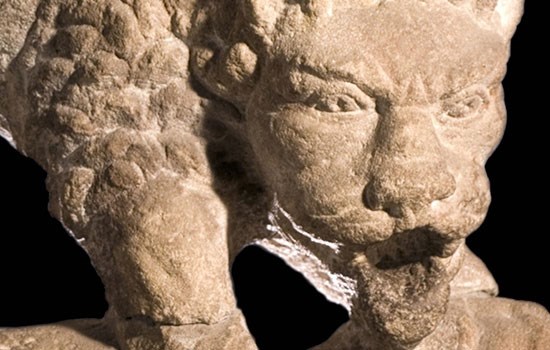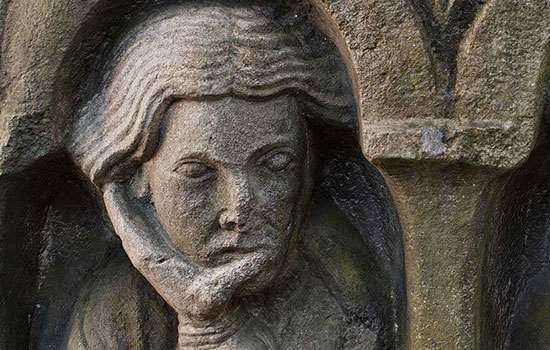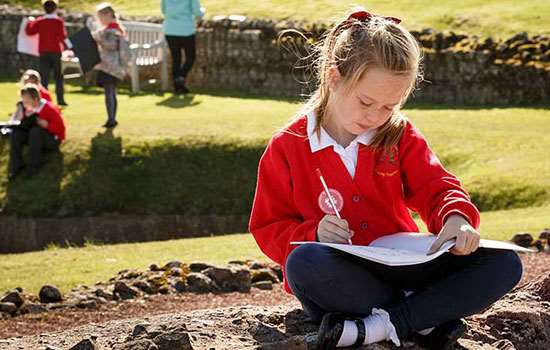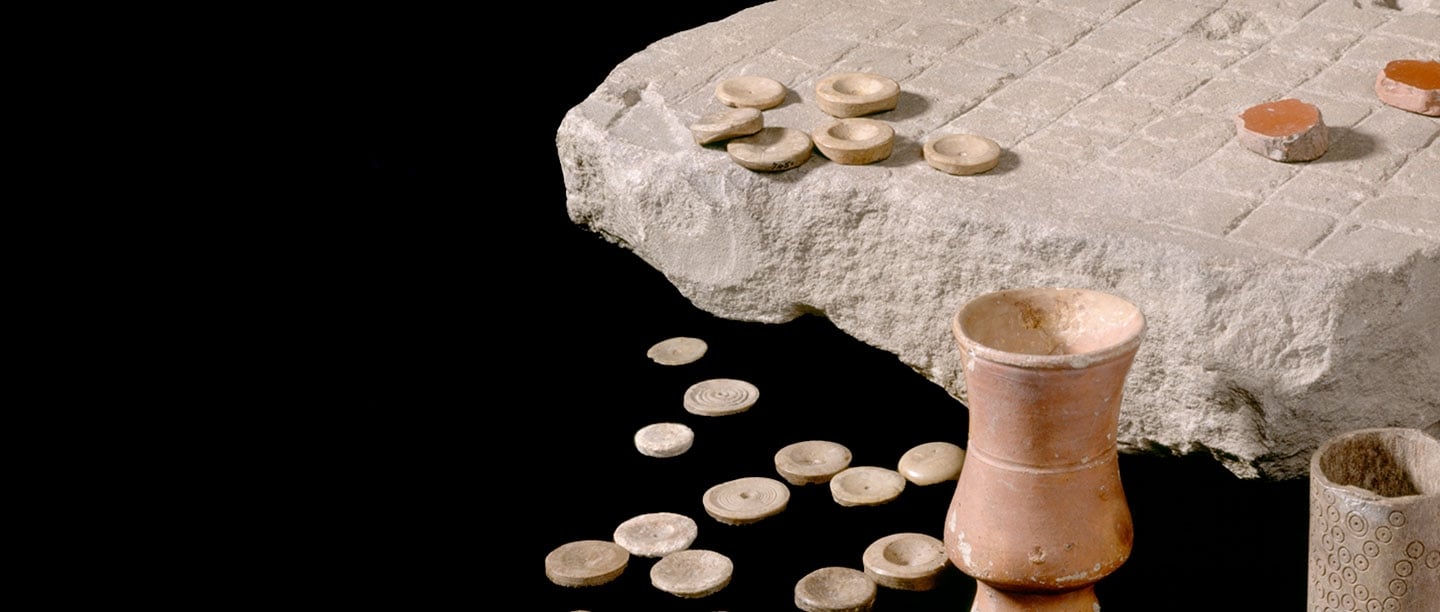Gaming on the Roman frontier
There are 689 gaming counters and 11 fragmentary gaming boards in English Heritage's collection from the forts and towns along Hadrian’s Wall alone. From these discoveries, we get a good sense of how Roman soldiers, civilians and families whiled away their spare time. Counters take many different forms: some slippery, bright glass, others carefully worked bone or pottery fragments rounded to an almost-circle. Many of the boards are fragmentary, so we cannot be certain of their original dimensions, which would allow a fuller understanding of gaming rules. It’s also possible that games would have been played on hastily etched boards on the ground or on buildings.
So what did they play? The Roman writers, Varro and Ovid, both mention a strategy game called latrunculi which may have been similar to chess. Unfortunately no sources record the official rules of the game but it could be that groups and families agreed variants on the ‘official’ rules, like many people today!
One Roman counter was found at Whitby Abbey in the grave of a child dating to the 7th or 8th century AD. The discovery shows this toy had a life well beyond the Roman occupation of Britain, which was hundreds of years earlier.
Kings, Queens, Bishops and Rooks
The origins of chess are somewhat obscure but it can be traced to an Indian game of war from the 7th century AD. It reached southern Europe before AD 1000 and spread north. Historical and archaeological evidence suggest it reached England after the Norman Conquest in 1066. The early figures were abstract in form to western audiences and later developed into the pieces we recognise more readily now. For example the Persian RUKHKH (rook) was originally a fortified chariot, depicted by a deep V-shaped notch on a rectangular block. Gradually the form developed, the rook becoming the more familiar castle we see today.
There are several medieval chess pieces in the English Heritage collections including two jet (a black coal-like stone) rooks excavated from Whitby Abbey and Rievaulx Abbey and a bone bishop in the form of a stylised elephant from Rievaulx Abbey. They are uncommon but not rare finds. There are over 50 examples known from England and include different pieces in bone (whale, ox, sheep), antler, ivory, wood and jet.
The presence of chess pieces at Rievaulx and Whitby shows that pastimes were part of the monastic lifestyle as well as that of wider society – a break from hours of work and devotion.
Merrilly away
Merrills (also known as Nine Men’s Morris), is a two-player strategy board game which appears to have originated in the Mediterranean or Middle East around 5,000 years ago. The aim of the game is to seize the opponent’s counters by forming mills (lines of three) on the board.
Despite the game being adopted by the Romans, in Britain merrills boards are relatively uncommon before the 11th century. Throughout the Middle Ages however, merrills became one of the most popular games played in Western Europe and is still played to this day.
Its popularity was probably due to the simplicity of creating the board and counters and the scalability of the game by adding more squares to the board (Twelve Men’s Morris). Boards were easily made by marking lines in stone, wood or earth. Some boards were portable and others were cut into architectural features. Similarly, counters could be crafted from bone, ceramic, stone or glass, but coloured pebbles were also used.
Merrills boards are found at many English Heritage sites including castles, medieval villages and even abbeys and priories.
Puzzling development
In the 19th century the idea of educational play became popular, and more and more publishers realised the value of promoting learning through games. Mapmakers and book publishers had the necessary skills to design beautifully illustrated games to both entertain and educate younger generations. These could take many forms, from instructional jigsaws and puzzles to complex games which helped children to learn about the history and geography of the British Empire. Religion often featured in games designed for children, and was also an important part of their education.
As the 20th century progressed, parlour games diversified from boards and other fixed forms, often incorporating energetic elements suitable for the whole family to play, particularly at seasonal celebrations such as Christmas.
One of the best examples of this in the collection at Brodsworth Hall is Jiggle-Joggle, a British-manufactured frog racing game, dating from the early part of the 20th century. To play the game, large colourful green cardboard frogs were tied to table or chair legs with cord and participants would ‘jiggle-joggle’ the cord to move the frogs along to a chosen winning line. The Brodsworth version is very worn and damaged – surely proof that Jiggle-Joggle was a hopping success with the family!
As the advertising rhyme suggests:
For a jig with a “Jiggle-Joggle”
And the wiggle-waggle-woggle
Of the frogs is not considered infra dig*.
It’s a game that will not bore you
And the youngsters they’ll adore you
For that “Jiggle-joggle-jiggle-joggle-jig!”
*’Infra dig’ is a casual phrase derived from the Latin infra dignitatem, meaning ‘beneath one’s dignity’.
Try playing at home
Merrills
This is a two player game. Each player has nine pieces which are placed and moved among the 24 spots on the board. The aim is to capture seven of your opponent’s pieces.
Download and print our merrills board or draw your own on a piece of paper. You will also need two sets of nine counters in two different colours. You can use our markers or make them yourself – why not get creative and paint small pebbles or stones?
To start the game, decide who should go first. Player One places a piece onto one of the spots. Player Two does the same and so on until all the pieces are on the board.
If either player forms a straight row of three pieces (a ‘mill’) then they may remove one of their opponent’s pieces. When all the pieces have been placed, players then take turns to move them around the board.
Counters can be moved by sliding them along a line to an adjacent spot. Again, if the player forms a ‘mill’ then they may remove an opponent’s piece. Players must remove other pieces first before removing a piece from a ‘mill’. Once a piece has been removed it cannot be used again.
Once a player has only two pieces left they have lost the game. Alternatively, if a player cannot move any of their pieces then they have also lost the game.
Download a Merrills board and counters (PDF)Jiggle-Joggle
To make your own version of Jiggle-Joggle, draw or paint a set of colourful frogs onto pieces of card. Large pieces of card work best. There is no limit to how many frogs can join in the race, the more the better! If you don’t like frogs, you can draw any animal. How about a set of jiggle-joggling pigs or dogs? Once you’ve designed your frog, carefully cut around the shape. Children, please ask an adult to help you with scissors.
If you would like some help with your designs, you can download, print and colour in our animal designs. Just stick them onto card before cutting them out.
Cut a small hole in the centre of each frog. Take a long piece of string or cord, and thread it through the hole, leaving both ends loose. You do not need to tie the string to the frog in any way. The length of string depends on how long you want your race to be, the longer the better.
To start, place all frogs in a row. Tie one end of the string of each frog to a chair or table leg. The chairs need to line up in a row so the frogs travel the same distance. The string needs to be tied about 20–30cm (9–12in) from the ground.
The players then take hold of the other end of the string. When the race begins, players tug and jerk the frogs so that they move along the string towards them. The first frog to pass the agreed winning line is the top frog!
If you want to, you can paint both sides of your frog. At the end of a game the frogs can be reversed and raced back to the start.
Download our animals to colour in (PDF)Explore more
-

Collections Highlights
English Heritage cares for more than 700,000 objects. Browse collections highlights from English Heritage sites across the country.
-

Histories
The places cared for by English Heritage span the story of England, from prehistory to the Cold War. Delve into our history pages to discover more about our sites.
-

Teaching and Learning Resources
We’re here to support your learning, whether you're a teacher looking to complement your lesson planning or a parent looking to enhance your child’s learning.

